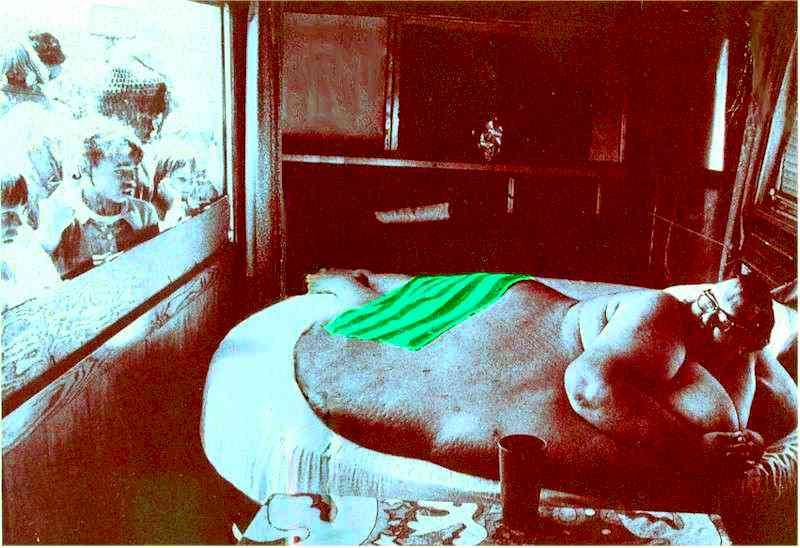Tattoo You
New Zealand International Tattoo Convention 1996Tattoos are like stories - they're symbolic of the important moments in your life. - Pamela Anderson
The Jim Beam Tattoo Awards were a key feature of the 1996 International Tattoo Convention held at Labour weekend at the Downtown Convention Centre in Auckland. People from all walks of life are fascinated with tattoos. This is evidenced by the fact that over 5,000 devotees attended the Convention during the 2 days it was open. Several artists from England and Australia were present as well as a large contingent of New Zealand artists. Noted artist Paulo Sulu'ape and his son represented the traditional Samoan style. Where did tattoos originate? For hundreds of years primitive people have made elaborate demon-repelling barriers and borders to stop the entrance of evil spirits. Painting are enclosed by frames to prevent evil forces attacking the unguarded picture and harming the owner. All human orifices were thought to be a temptation to evil spirits and one form of magical protection against entrance by demons was to create borders via tattooing the areas near the ears, nose, and especially the mouth and sexual organs. (However, you will probably have noticed that none of these photos illustrate sexual organ tattoos.) Today, tattoo art has become more of a cult thing. Most people no longer wear tattoos for protection although there is still a magical stigma attached - an awakening of the spirit within. (MANY celebrities sport tattoos.) Almost 200 people entered the Tattoo Awards. Judging criteria was as follows:
The body is the canvas; only the art was being judged, not the person wearing the tattoo. Judging for the finals was left to the visiting overseas artists. As shown in the sample of photos, some of the entries were impressive!
Source: Brand News date unknown (presumably late 1996)
Another Tattooed Group...
Source: fire.prohosting.com
Tied Up, Tied Down
Source: www.thesun.co.uk sent to them by Sean Ryan
I can understand the drive to decorate one's body. But I would have to question the permanence of extensive tattoos. Youthful exuberance can morph into seriousness in later life when one could be passed over for important jobs or promotions. The development of "dissolvable" tattoos which last until some special treatment was applied would be nice. Meanwhile, I would suggest keeping tattoos modest, avoiding others' names, political slogans, pornography or "Mom". Also, ensure needles are disposable or properly cleansed. But I'm not likely to influence any potential tattooee, am I? (?) My, what an interesting word!
Self-inflicted tattoo/brand
Obsess Much?"Tiger Man" Wants Fur Graft
A San Diego computer programmer who has spent £100,000 on tattoos and plastic surgery to turn himself into a "tiger" wants a fur graft. Dennis Smith is tattooed from head to toe with orange and black stripes and his teeth have been filed to needle point. He has also had latex whiskers implanted and surgery to his lips so he has a permanent snarl. He now wants a surgeon to graft tiger fur on to his skin, like a perma-wig. Mr Smith, who has changed his name by deed poll to Cat Man, said: "I have a collection of old tiger pelts from the days of hunting. I want these grafted on to me. It will cost another $100,000 but will be worth it. "When I have the coat of a tiger, I feel I will have reached my goal in life." His fingernails have been crafted into sharp talons while his hands have tattooed markings like a tiger's paws. He says he feels like a tiger. The short back-and-sides he sported at the University of California has been replaced with a long orange mane. He has also swapped his glasses for green contact lenses. He holds down a £80,000-a-year computer programming job which enables him to fund the surgery, the Daily Record reports. He admitted: "Of course people stare at me when I walk down the street but that's the effect I desire. For so long I have equated myself with the tiger that I decided to change myself into one. It's the real me. So many men cross-dress without their partners knowing, or dress up and play cowboys or Civil War soldiers at weekends. Me, I'm a tiger all the time and I love it. I had my first tattoos done 20 years ago around my eyes and now my whole body is one pastiche of stripes and shading. I am really proud of it all." Source: Ananova Thursday 2nd August 2001
A 6 September 2008 article in Britain's Daily Mail says that this man is named Dennis Avner, not Dennis Smith. It further says Dennis, 50, is from Tonopah, Nevada, is descended from Huron native Americans, and (unsurprisingly) remains unmarried.
Leopard Man Shuns Society for Hut on Isle of Skye
Tom Leppard shows off his spots (NEWSLINE) A tattooed hermit known as the Leopard Man of Skye lives in a hut made of sticks and stones and bathes in a river. Tom Leppard dropped out of society years ago after spending £5,500 to have his body covered in spots. Once a week, the ex-soldier goes by canoe to buy supplies and pick up his pension. Mr Leppard told Grampian Television: "I spent too long in the forces, 28 years. I couldn't mix with ordinary people. I decided I wanted to be the biggest of something, the only one of something. It had to be a tattoo, one tattoo. This is one tattoo." Mr Leppard, who also has a set of fangs, is recognised by the Guinness Book of Records as the most tattooed man on earth. He says he would be plagued by "interfering busybodies" and children throwing stones at his window if he went back to civilisation. Source: ananova.com 29th October 2001 See also:
What Your Tattoo Says about Youby A Bogus
Source: funkysmell.com
A Canvas of Skin
Tattoos are known around the world as, tatoeage, tatouage, tätowier, tatuaggio, tatuar, tatuaje, tatoos, tattueringar, tatuagens, tatoveringer, tatto, and tatu, and are more popular now than at any time in recorded history. In 1936 Life Magazine estimated that 10 million Americans, or approximately 6% of the population had at least one tattoo. And it was estimated that fully a third of that number were tattooed as a result of being a member of the Armed Services, especially the Navy and the Marines. The National Geographic News stated in April 2000, that 15% of Americans were tattooed. The Alliance of Professional Tattooists, an industry group based in Annapolis, puts the numbers at one in seven, or 39 million Americans, an impressive doubling of the numbers of tattooed people since 1990. Details Magazine published a poll that estimated that 22% of those aged 18 - 25 were tattooed. So what has happened in the last ten years? It's the media, baby. In the early '90's Cher and her tattoos were big news. Like her or loathe her there was no denying her public profile. And part of what made Cher's tattoos newsworthy was the fact that she was a prominent musician, television personality and Oscar winning actress who was willing to flaunt her body art. Cher brought tattooing out of the closet for celebrity skin. The result has been a virtual cornucopia of beautiful celebrity women sporting ink. The list includes pop stars, playmates, super models and some of the hottest actresses in Hollywood. Some of the most popular actresses today have not just one tattoo, but an impressive collection. These include Drew Barrymoore, Christina Ricci, Angelina Jolie, Alyssa Milano, Cristina Applegate, Pamela Anderson, Gillian Anderson, Janet Jackson, Mel Chisholm, Sarah Michelle Gellar, Britney Spears, Christy Turlington, Kate Moss, Charlize Theron, Melanie Griffith, Heather Locklear, Roseanne, and (last but not least) Courtney Love. Tattooed males include Ben Affleck, Tommy Lee, Johnny Depp and Nicholas Cage. Source: vanishingtattoo.com
Funny Tattoos
Source: lila.yft.com
So Dyed He DiedTattoo Man's Ordeal Ends in Deathby Alan Perrott and Martin Johnston Peta Leota-Tui threatened to end her marriage to stop her husband getting the backstreet cultural tattoos she believes killed him. James Leota-Tui died in the intensive care unit at Middlemore Hospital this week from an infection, three days after abandoning his second attempt to complete a traditional Samoan body tattoo. The dark tattoos covered his body from navel to knees and as a new matai, or head of his extended family, the 29-year-old was determined to endure the same tattoo ritual his father had. An autopsy has been performed. Police and public health officials are investigating the cause of death and charges may be laid. The infection is understood to have involved the flesh-eating disease necrotising fasciitis, often caused by a strain of the streptococcal bug. Tissue from Mr Leota-Tui, and the tattoo equipment used, is being tested for this and other bacteria. The police are investigating under the Crimes Act, which requires that surgical procedures be performed with a reasonable standard of care. The death has awakened concerns about hygiene standards in unlicensed, backroom operations that have sprung up to cater for the resurgence in interest among young Pacific Islanders for "tatau". Grey Lynn cultural tattooist Inia Taylor wants a crackdown on backstreet operators, who he says discredit his craft and endanger the health of their customers. "I have heard some real horror stories. I have travelled around the Pacific for years learning how to do traditional, cultural work. Being clean as well doesn't make my tattoos any less cultural." Peta Leota-Tui, a school teacher, said she repeatedly tried to stop her husband's ordeal after he became ill in April during the first round of tattoos. She was alarmed by the poor hygiene practices, especially when the tattoos on her husband's back were slow to heal. Despite a period of recovery, Mr Leota-Tui was sent home from his job as a tyre retreader because his wounds were still open. "It came to the point that I tried to threaten him over our relationship," said Mrs Leota-Tui as she held their 2-year-old son, Juan-Pedro. "I didn't see the point of it. I know it's traditional, but tattoos aren't going to pay my bills. James had been looking forward to a big party this month for his 30th. Now we're going to have a big funeral instead." Photographs taken in April show Mr Leota-Tui being worked on by 4 men including the tattooist hired by the dead man's family for $1,500. He is lying on several stained pillows on a mat in his parents' home. Only one of the men is wearing gloves - and only because Mr Leota-Tui brought them with him. The tattooist told Mrs Leota-Tui he cleaned his traditional bone tools with Dettol. The Weekend Herald has been unable to contact the tattooist. Despite pain from the first tattoos and Mrs Leota-Tui's objections, the work resumed on 24 June. Within several days, Mr Leota-Tui had weakened so badly the tattooing was stopped. His health deteriorated quickly. Mrs Leota-Tui desperately called her husband's family for help last Sunday. An ambulance was eventually called and medics tried to resuscitate him before taking him to Middlemore Hospital. After being treated for 15 hours, he died about 4.30pm on Monday. Mrs Leota-Tui has not heard from the tattooist since. She says her husband's father tried to persuade his sons not to undergo the test of strength and stamina, but James was determined, especially as none of his brothers had been tattooed. The procedure is usually carried out only by certain families who have performed the ritual for generations. The most famous is the Sulu'ape family, members of which fly from Samoa to perform the 3-week tattoo for between $2,500 and $3,000. Mr Leota-Tui was buried yesterday, the same day as a new Manukau City Council bylaw on tattoos and body piercings came into force. Cultural tattooists are exempt from the new licensing rules, but will be expected to follow health and hygiene guidelines which are yet to be established. The Manukau City environmental health team leader, Ian Milnes, expects the guidelines to be effective, but said enforcing them on underground tattooists was always difficult. The Health Ministry's director of public health, Dr Colin Tukuitonga, said the link between tattooing and necrotising fasciitis in Mr Leota-Tui was not yet proven, but most likely. Pa'u Tafa Mulitalo, a lecturer in social and cultural studies at Massey University, Albany, said there had been a renaissance of "tatau", tattoos, among young Samoan men - "they are very proud of it. It's highly respected in Samoan society and it's becoming a fashion in New Zealand now." Source: nzherald.co.nz 6 July 2002
Traditional Tattooist Linked to Second Scareby Alan Perrott Further allegations of dangerous health practices have been made against the tattooist who worked on a Wiri man who died. The tattooist had been performing a traditional Samoan body tattoo, a "pe'a", on 29-year-old James Leota-Tui for five days until his failing health ended the procedure on 28 June. Mr Leota-Tui was taken to Middlemore Hospital on 1 July but died that afternoon from infections involving septicaemia and the flesh-eating disease necrotising fasciitis. Results of an autopsy have not been released, but doctors and Mr Leota-Tui's wife believe the infection was related to the tattoo. The Herald visited the tattooist's home yesterday as police arrived to interview the man. His wife said they would not be making any public comment. Robert Siataga, now living in Christchurch, told the Herald yesterday that he almost died after receiving a pe'a from the same tattooist in 1998. Mr Siataga said that during the procedure, the tattooist washed his "blood-soaked, ink-stained cloth" in the same sink used to wash hands, rinse cups and fill the kettle. He once waited as a woman was tattooed, then watched as the man waved his tattooing tool in a bowl of water and disinfectant before using it on him. "He sharpened his tool while holding it with his toe, then tested it on his assistant's arm before starting back on me." After 2 days the pain was so bad that Mr Siataga ended the process. He said he was badly infected and broke out in boils as his legs swelled enormously. "I just thought everyone went through the same thing. A couple of times I felt close to death - I could feel the life drifting out of me." A friend who had helped other family members to get body tattoos found him, took him home and massaged pus out of his body for four days. "I was told I was close to total system collapse," said Mr Siataga. "I couldn't walk for 4 weeks." Despite his ordeal, he returned to have the tattoo completed because he feared the public shame that would result if he did not. Mr Siataga said he later found out that a cousin had a tattoo from the same man a year earlier and suffered similar health effects. "I wouldn't recommend [the tattooist] to anyone," he said. While still endorsing the traditional ritual, Mr Siataga wants effective enforcement of minimum health standards and more information made available on the risks involved and recovery techniques. Dr Tom Robinson, a public health registrar, is investigating the death of Mr Leota-Tui. He said the resulting report was likely to recommend further development of regulations on cultural tattooing. The Manukau City Council is developing its own guidelines after exempting cultural tattooists from a bylaw regulating tattoos and body piercing. Source: nzherald.co.nz 12 July 2002
Study Ties Tattoos to "Hidden" Hepatitis C InfectionPeople with tattoos may be infected with hepatitis C but not realise it, says a study from the University of Texas Southwestern Medical Center. Researchers studied 626 patients being treated at a clinic for unrelated reasons. Those who did not know they were infected with the bloodborne virus were interviewed for risk factors and tested. Of the 626 patients, 113 had tattoos. Of those, 22% were infected with hepatitis C, compared with 3.5% of the tattoo-free patients. Of the 52 who had gotten tattoos in commercial parlours, 33% had hepatitis C. In all, commercial tattoos accounted for twice as much hepatitis C infection as injection drug use. The patients in the study were interviewed and tested in 1991 and 1992, before widespread hepatitis C testing was done. Hepatitis C causes up to 10,000 deaths a year and about 4 million people carry the infection. Source: USA Today Monday 16 April 2001 "Health and Behaviour"
Study: Tattoo Ink May Contain Heavy Metalsby Amy Norton New York - Dirty needles may be the chief health concern with tattoos, but preliminary research suggests the inks used to make the body art may harbour potentially toxic heavy metals. In an analysis of 17 tattoo inks from 5 manufacturers, researchers found evidence of a number of different metals, such as nickel and copper, in the products. It's unclear how much metal may be in the different inks - or whether there is any health risk. Still, the study authors say the findings highlight the lack of oversight of tattoo ink manufacturing. The US Food and Drug Administration which approves the colour additives used in foods, cosmetics and drugs, does not regulate the inks used for tattooing, and no colour additive has ever been approved for injection into the skin. "A lot of people are surprised by that," said Leslie Wagner, a chemistry student at Northern Arizona University in Flagstaff and a co-author on the new study. Many tattoo enthusiasts may assume that an ink that's injected into the skin has been approved by regulators to meet certain standards. However, it is not even clear what goes into a given tattoo pigment. Because the inks are not sold directly to consumers, manufacturers are not required to list the components on the product label, according to the FDA. And no previous scientific studies have attempted to describe the composition of the inks, Wagner said. In their research, Wagner and co-author Haley Finley-Jones have so far found that tattoo ink compositions vary from manufacturer to manufacturer, and from colour to colour. Moreover, Wagner said, "we've found a lot of indications of metals." She and Finley-Jones presented the preliminary findings Sunday in San Diego, at the 229th national meeting of the American Chemical Society. Tests are still underway to confirm the identities of all the metals in the tattoo inks, as well as the concentrations present. The health effects, if any, will require further research, according to Wagner. However, she pointed to reports of certain tattoo complications for which the causes are currently unknown. People have, for example, been burned in tattooed skin areas during MRI scans, while others have developed allergic reactions to tattoo inks. Whether the presence of metals in the inks has anything to do with these problems is not yet clear, according to Wagner. "We're not trying to make any big claims that this is harmful," she said. Even if tattoo ink components turn out to have no ill health effects, knowing their make-up could at least make things for easier for those who have second thoughts about their body art, Wagner noted. Right now, tattoo removal is a fairly difficult process - often requiring several laser treatments to lighten the tattoo, with varying aesthetic results. It's possible, Wagner said, that knowing the exact composition of tattoo pigments will help refine tattoo removal techniques. Source: news.yahoo.com Reuters Health Monday 14 March 2004
Getting Rid of Those Old TattoosDermatologists should be aware of "overtattooing," a pigment removal technique known to tattoo artists for decades, said Dr Whitney D Tope at a symposium on cutaneous laser surgery sponsored by SkinCare Physicians of Chestnut Hill. In overtattooing, the tattoo artist will dip the machine's tip in saline or another nonpigment solution and will tattoo over the existing pigment. According to Dr Tope, director of the cutaneous surgery and laser centre at the University of Minnesota Hospital and Clinics in Minneapolis, overtattooing creates a perforating disorder in which the epithelium grows down around the pigment fragments, picks them up, and eventually extrudes them. Danny Fowler, a tattoo artist with 33 years of experience who designs and manufactures tattooing equipment through his company, Time Machine Incorporated in Roanoke, Virginia, agreed that overtattoing can be effective for removing pigment. In an interview, he said that the technique works especially well for tattoos on the hands, where the skin renews itself rapidly. On other parts of the body, such as the upper arm, overtattooing will remove the pigment but may leave scar tissue. Although some believe that newer tattoos are more responsive to removal by overtattooing, Dr Tope noted there are no data on this. He recommended that dermatologists develop an alliance with a local tattoo artist so that they can perform this technique when necessary. Finding such a partner could prove difficult, Mr Fowler said, since more and more tattoo artists are purchasing their own Q-switched lasers for tattoo removal. Those who have their own lasers may regard dermatologists as business competitors. Dr Tope noted that tattoo artists are historically suspicious of physicians, worrying when a physician walks in the door that his or her true intent is to bring down the wrath of the health department on the tattoo studio. "I think the attitudes are changing," said Dr Tope. "It's really a matter of creating the right kind of relationship and finding somebody who can do this for you." In looking for a reputable artist, Mr Fowler recommended finding "the guy in the worst location with the longest line." This is probably a person who has decades of experience and who has developed a strong local reputation yet has never moved his shop from its original location in an older part of town. Source: Was located at xztx.hypermart.net on 22 October 2001 - however that site is no longer available.
Lower Back Tattoo Removal
Click to Play For a real site on removing tattoos, see www4.ncsu.edu. Be warned that it is a lengthy, difficult and painful process that may leave serious scars.
Unwanted Tattoos Can Be Removed by Cream Injected into Skin - without Pain or Scarring
Rejuvi cream is injected through tiny needles and causes the ink to come to the surface of the skin, form a scab and then drop off. by Rebecca Camber Tattoos can often be a case of ink now, regret later. Extracting the dye from the skin has usually been a painful process. However, cosmetic surgeons are now offering what they say is a more efficient and less painful way of removing body art. A cream called Rejuvi can be injected into the skin in much the same way as the ink is injected into the top layers of the epidermis to create the tattoo. The Rejuvi is said to be absorbed by the pigmented cells and to bond with the pigment. This softens the ink and pushes it to the surface of the skin where it forms a scab. When the scab falls off after 6 - 8 weeks, the ink goes with it. It is claimed that the technique, first used in the US, has a higher success rate than laser treatment, is cheaper, less painful and has a minimal risk of scarring. Stuart Harrison, director of clinics just starting to use the process said that the procedure was "uncomfortable rather than painful but...less painful than having the tattoo itself [or] having laser treatment. Laser works by breaking up ink pigmentation; however, this works by using the body's natural processes. The reason a tattoo stays is a coating is put around the ink to protect it from the body's immune response. This cream makes the ink identifiable to the body so that it [rejects] it and heal[s] itself." Until recently the only way of using the cream was forcing it into the skin - which had a cheese grater effect. Now a new micropigmentation gun can apply cream under the surface of the skin without scarring. Previously the most popular method of removal in the UK has been laser treatment which breaks up the tattoo pigment, flushing particles away through the immune system. However, it can take several treatments and some complain the ink never completely fades. Other treatments include a skin peeling acid or dermabrasion which involves freezing the skin and sloughing it off with a rotary tool. It can lead to scarring and even a skin graft. Some tattoos are surgically cut out but only when they are too deep to be treated with laser. It is claimed that this cream has a minimal risk of scarring. However, the efficacy of Rejuvi has been questioned on some US chat forums. Source: dailymail.co.uk 27 August 2008
Think Before You Ink: Are Tattoos Safe?As the popularity of tattoos continues to grow, so does the concern about potential risks. Some risks, such as the spread of infections through the use of unsterilised needles, have long been known. But what isn't clear is the safety of tattoo inks. Permanent tattoos are made by using needles to inject coloured ink below the skin's surface. Permanent make-up is considered a permanent tattoo that mimics the results of cosmetic products such as an eyebrow pencil, lip liner, eyeliner, or blush. While state and local authorities oversee the practice of tattooing, ink and ink colourings (pigments) used in tattoos are subject to FDA regulation as cosmetics and color additives. However, because of other public health priorities and a previous lack of evidence of safety concerns, FDA has not traditionally regulated tattoo inks or the pigments used in them. FDA has received reports of bad reactions to tattoo inks right after tattooing or even years later. Some people report itchy or inflamed skin around their tattoos in the summer when they've been out in the sun. Recent reports associated with permanent make-up inks have prompted FDA to study tattoo ink safety. "Our hope is to get a better understanding of the body's response to tattoos and their impact on human health, and to identify products at greatest risk," says Linda Katz MD, MPH, Director of FDA's Office of Cosmetics and Colors in the Center for Food Safety and Applied Nutrition. What are the Risks?
Tattoo Ink ResearchIn a laboratory within FDA's Arkansas-based National Center for Toxicological Research (NCTR), research chemist Paul Howard, PhD and his team are investigating tattoo inks to find out
"There have been no systematic studies of the safety of tattoo inks," says Howard, "so we are trying to ask - and answer - some fundamental questions." For example, some tattoos fade over time or fade when they are exposed to sunlight. And laser light is used to remove tattoos. "We want to know what happens to the ink," says Howard. "Where does the pigment go?" NCTR researchers are exploring several possibilities:
Tattoo Tips for ConsumersInk:
Permanence:
If you need to have an MRI done, don't avoid it. Inform the radiologist or technician that you have a tattoo so appropriate precautions can be taken. Source: fda.gov 6 December 2007
Tattoo Alternatives
Exposing Shallownessby Theodore Dalrymple A review of the book Bodies of Inscription: A Cultural History of the Modern Tattoo Community by Margo DeMello Duke University Press
In fact, more than 95% of imprisoned white British criminals are tattooed. The statistical association between tattooing and criminality is very much stronger (with the exception of that between criminality and smoking) than that with any of the more conventionally investigated factors, such as broken homes, drug addiction, low intelligence, and poor educational attainment. Show me a man’s tattoos, and I will tell you his criminal record: British men, for example, who were incarcerated before the age of 21 usually bear a blue spot tattooed over one cheekbone, the criminal’s equivalent of the old school tie, and a surprisingly large proportion of petty drug dealers have a tree-frog green cannabis leaf tattooed prominently on their person (sometimes on their face or neck), a clue whose meaning even a Dr Watson might have little difficulty in deciphering. The tattoo in modern society is thus a subject of greater interest and deeper significance than might at first be supposed, a subject worthy of reflection and a possible departure point for an assessment of the soul of modern man. Margo DeMello’s Bodies of Inscription provides - often without really meaning to - some material for such an assessment. The author, an anthropologist, is herself a member of "the tattoo community," that is to say, is heavily tattooed, an avid reader of tattoo magazines, and an occasional attender of tattooing conventions. Her book, therefore, may be said to be in the tradition of participant observation. Despite the ominously deconstructionist title, she writes clearly and without jargon. This alone is quite a lot to be grateful for, even if her insights are largely superficial and the reader cannot rely on her as a guide to the deeper meaning of the things she describes. In fact, her book is largely concerned with a comparatively recent phenomenon: the spread of tattooing to the American middle classes. This is also a British, and no doubt a European and Australian, phenomenon. The tattoo was once a resolutely proletarian form of body adornment which the middle classes regarded as symbolic of lower-class savagery, bad taste, and irresponsibility (the decision to be tattooed was, indeed, often taken while drunk in the company of other drunks). A middle-class person who had himself tattooed was thereby at once déclassé: a slide down the social scale more precipitous and serious than that brought about by a mésalliance, insofar as tattoos last longer, and are more difficult to obliterate, than marriages contracted in haste. The tattoo is now seeping through society like ink through blotting paper. I first became aware of this seepage when I noticed an increasing number of young women in my hospital ward who bore tattoos, the tattoo having been until then an almost exclusively male embellishment. At first, women’s tattoos were small and on parts of the anatomy that were usually covered by clothes; gradually these tentative essays in the direction of male proletarian savagery have been replaced by larger, more prominent and brazen declarations of allegiance to it. Having crossed the gulf between the sexes, the tattoo then began its creep up the social scale. Young celebrities sported their tattoos when they were photographed for the newspapers, and before long I noticed that a number of university students among my patients also bore tattoos. This was unthinkable only a few years ago. Perhaps the ne plus ultra of this trend occurred when a young member of the British royal family exposed her pierced tongue (body piercing being a closely cognate phenomenon to tattooing) to the public. According to Ms DeMello, however, the middle-class tattoo differs from the proletarian variety. The latter is formulaic: when self-inflicted with a needle and India ink, it usually consists of simple symbols or acronyms, for example (in England) the letters ACAB, which stand either for "All Coppers Are Bastards" or "Always Carry A Bible," depending upon whether the person is asked about the meaning of the tattoo before or after an arrest. Proletarian tattoos done by professional tattooists are similarly formulaic: the customer simply choosing a well-established pattern from those on photographic display in the tattoo parlour. If proletarian tattoos are ready-made, tattoos for the middle classes are individually tailored to their requirements by those whom the author insists upon calling "artists." It is perfectly true, of course, that tattooists sometimes display an astonishing skill in the production of images on, or in, their clients’ skin, which are of photographic verisimilitude, and many even hold university degrees in fine arts, but skill alone, no matter how advanced or refined, does not make an artist. To think so is to confuse a necessary with a sufficient condition; indeed, there is very little more appalling than great skill in the service of bad taste and barbarism. In any case, the individuality of the designs chosen for their tattoos by the middle classes is strictly relative. The iconography is limited and depressingly reminiscent of the "art" produced by prisoners, which is violent, crude, garish and pagan, however well-executed. It is a visual exhibition of modern superstition, the superstition of people who have strong emotions but weak minds and a very limited cultural and historical frame of reference. Why do members of the middle classes now adorn themselves in this savage fashion? The author draws not only on her own experience, but also upon that of tattooists and their customers. She believes that tattoos have philosophical meaning for those who bear them. The philosophy in question is a witches’ brew of new age "spiritualism," ecological paganism, elevation of the primitive, and vegetarianism. It is the kind of philosophy that emerges when religious feeling is no longer disciplined by religious ritual that is established by tradition and upheld by social pressure. It is perfectly possible, however, to be a vegetarian, or even to believe in witchcraft, without resort to the tattoo parlour. What makes individuals choose to undergo the painful, expensive, and virtually irrevocable process of tattooing? Having listened to an unspecified number of tattooed members of the middle classes, the author identifies several motives, all of which struck me as unflatteringly revealing of the soul of modern man. First there is the assertion of individuality. One of the author’s informants says,
This is infinitely sad. That a person’s individuality should be made to depend upon so crude an outward sign as a tattoo is in fact an indication of the fragility of that person’s identity. He must feel simultaneously overwhelmed by the sheer numbers of people around him who make it so very difficult for him to differentiate himself from them, and an urgent necessity to do so. This necessity is all the more imperative in an age of celebrity, when fame and public notoriety are to so many people the only goals worth pursuing: indeed, when public adulation itself seems almost the sole guarantor of true personal existence. But their reach exceeds their grasp. Of course, such outward signs of individuality as tattoos are inherently self-defeating. It cannot ever be long before someone has himself tattooed in a yet more startling, more "original" fashion (indeed, tattoo conventions regularly offer prizes for the "most unique" tattoo). But there is a deeper reason why such efforts at asserting one’s unique individuality are pathetically bound to fail: for true individuality does not arise from a decision to be an individual. A man who decides to be an eccentric, and therefore to behave eccentrically, is not an eccentric at all, but an actor, and usually a bad one at that. A true eccentric is a man who behaves eccentrically because it simply does not occur to him to behave otherwise. "Personal growth" is cited as another important motive for having oneself tattooed. It is said to be "empowering." A woman who had a bad marriage had herself tattooed with a wolf.
Another woman said that her tattoo was something she did, that she brought into being, as if the fact that it was hers were a sufficient guarantee of its worth. What is striking about these "tattoo narratives" (as the author calls them) is their vacuous egoism. The interlocutors speak, and appear to think, in pure psychobabble, that debased and vague confessional language that allows people to imagine they are baring their souls when in fact they are exposing their shallowness. This is something the author does not notice because she herself belongs to the psychobabble culture. One cannot but feel sorrow for people who think that by permanently disfiguring themselves they are somehow declaring their independence or expressing their individuality. The tattoo has a profound meaning: the superficiality of modern man’s existence. The author entirely misses the cultural significance of the spread of tattoos into the middle classes, even though one of her interlocutors, a teacher at a university, gives her a strong clue:
Here we see the bodily consequence of an intellectual climate that has long extolled opposition and hostility to what exists as the only honourable and ethical stand to take towards it. Of course, such an attitude is fundamentally ahistorical and lacking in respect for the achievements of the past, and only people who live in an eternal, egoistic present moment could adopt it. (The eternity of the present moment is, of course, the key to modern shallowness.) The tattoo is thus the art form of the cultural vandal, and it is no accident, as the Marxists used to say, that the cultural vandal’s views should almost always be expressed with inarticulate sub-demotic vulgarity. It is also no accident that some members of the middle classes should have adopted a typically proletarian form of bodily adornment as a badge not only of independence, but also of liberal virtue. A tattoo establishes them as tolerant, open-minded, and sympathetic towards those below them in the social scale: the highest virtues of which they can conceive. The tattoo thus appeals to the kind of modern bourgeois who believes that foulness of language is a token of purity of heart, or at least of sincerity. The tattoo, like the constant resort to the swearword, is an attack on bourgeois propriety, and as such a demonstration of largeness of heart and generosity of spirit. Of course, this antinomianism (itself so tiresomely bourgeois) has a tinny ring. I am reminded of the recent obituary of a British pop star in The Daily Telegraph (the fact that this newspaper, once the favorite reading matter of retired admirals pickled in port, should carry obituaries of pop stars at all is itself a cultural shift of some significance). The subject of the obituary was said to have been so irritated by what he considered the false gentility of the school he attended that he forever after used the demotic speech of South London. In other words, he adopted, in the name of authenticity, a form of language that was not his own and did not come naturally to him. The fate of all people who imitate others to achieve authenticity is to live a lie. Besides, the bourgeois who has himself tattooed is, as this book indicates, at least as anxious to distinguish himself from the real proletarian as he is to identify with him. The tattoo is thus to the modern bourgeois what playing shepherdess was to Marie Antoinette. The woman whose tattoo was supposed to say "Fuck you" to her university did not really want to become the janitor of her faculty building, and probably would have very little to say to him. Egalitarians usually have a very strong sense of hierarchy. Bodies of Inscription is a superficial examination of a social phenomenon of considerable cultural significance, but it will nonetheless be of great interest to people who know how to read between the lines. Theodore Dalrymple is actually Anthony Daniels, who was a doctor for the NHS in the UK until just recently. He has retired, and has been saying for some months that he will be moving to France to escape the barbarity that has overtaken his country. Much of Dalrymple's best writing draws on his medical experience, which, given the nature of his practice, was often bleak but instructive. He frequently writes about what people in the US call the underclass. Source: newcriterion.com The New Criterion Vol. 18, No. 10, June 2000 © The New Criterion
Some BodyPerhaps tattoos would have been better?
Chris Walker had fought in the Korean War. He suffered from post-traumatic stress disorder and tried to kill himself by overeating, until he began making his living as "the fattest man in the world" (he was not entered in the Guinness Book of Records - the approved scales were too small for him to use). Source: Granta 39: The Body Spring 1992 "Antonin Kratochvil Sideshow"\ The record for the heaviest man ever is held by Jon Brower Minnoch, who died in Seattle in 1983 after reaching a record 635kg. He was in his early 40s.
For more on the unusual: events, abilities, means of self-expression, houses, conditions, people, luck, narrow escapes, resemblances, facts, diversions, heroism and more - click the "Up" button below to
take you to the Index page for this Odds and Oddities section. |
 Animals
Animals Animation
Animation Art of Playing Cards
Art of Playing Cards Drugs
Drugs Education
Education Environment
Environment Flying
Flying History
History Humour
Humour Immigration
Immigration Info/Tech
Info/Tech Intellectual/Entertaining
Intellectual/Entertaining Lifestyles
Lifestyles Men
Men Money/Politics/Law
Money/Politics/Law New Jersey
New Jersey Odds and Oddities
Odds and Oddities Older & Under
Older & Under Photography
Photography Prisons
Prisons Relationships
Relationships Science
Science Social/Cultural
Social/Cultural Terrorism
Terrorism Wellington
Wellington Working
Working Zero Return Investment
Zero Return Investment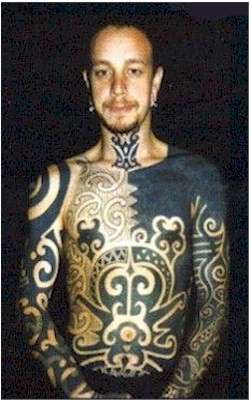
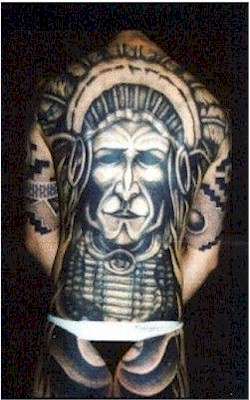
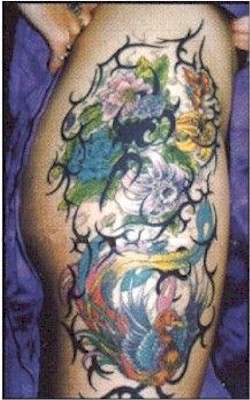
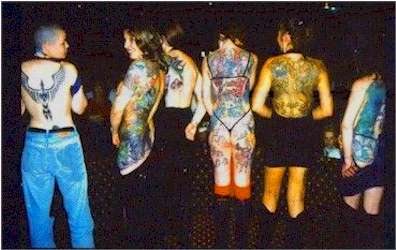
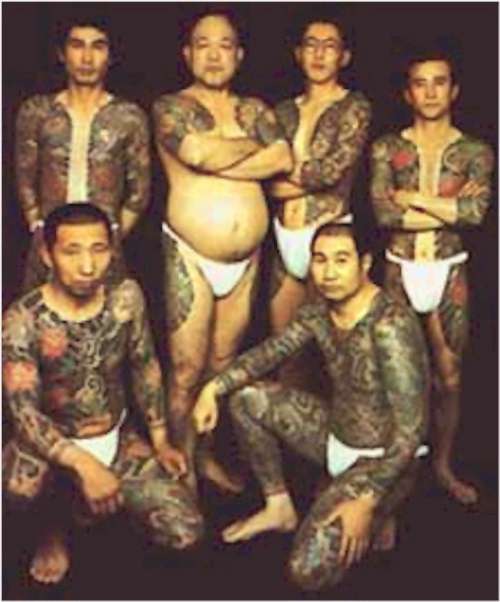
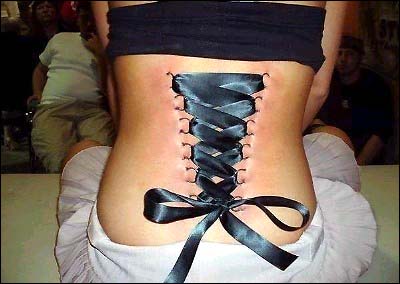
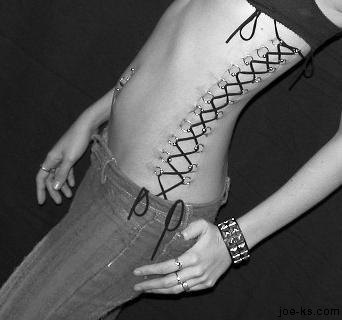
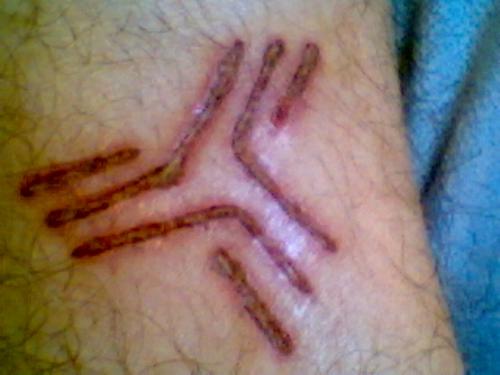
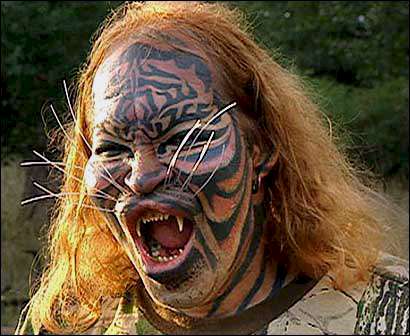
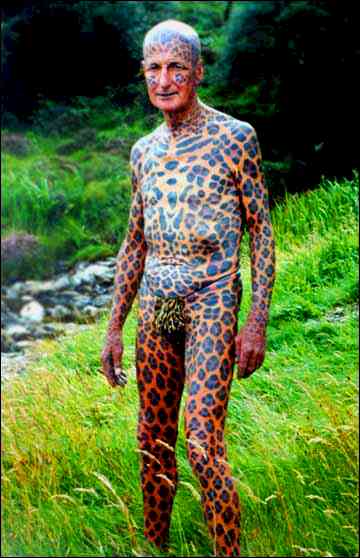
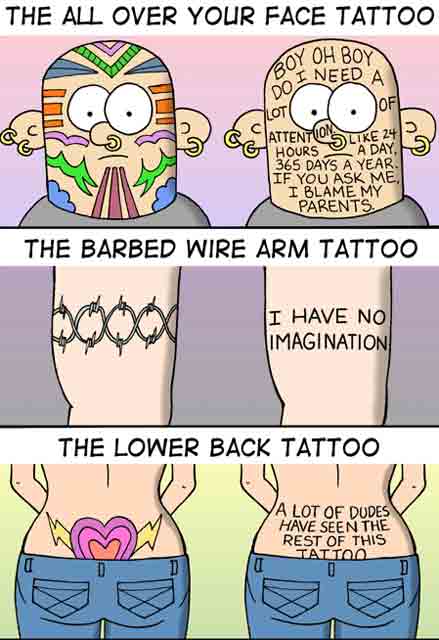

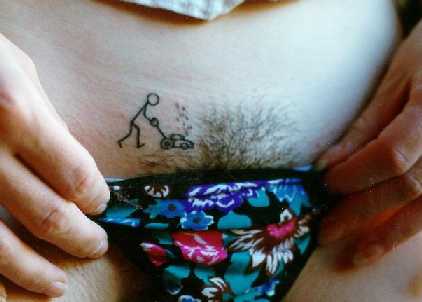
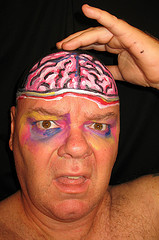
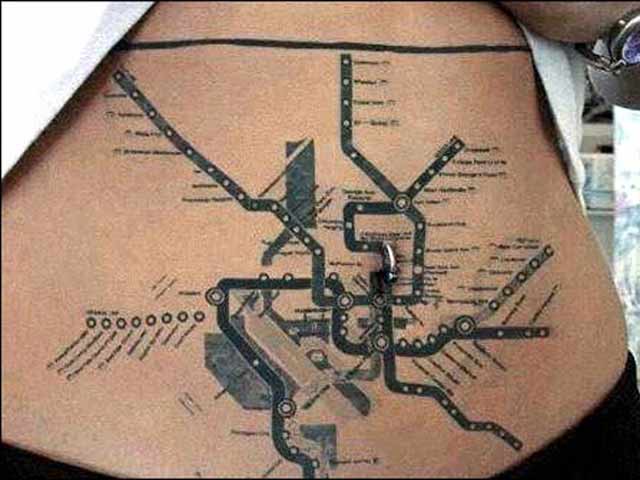
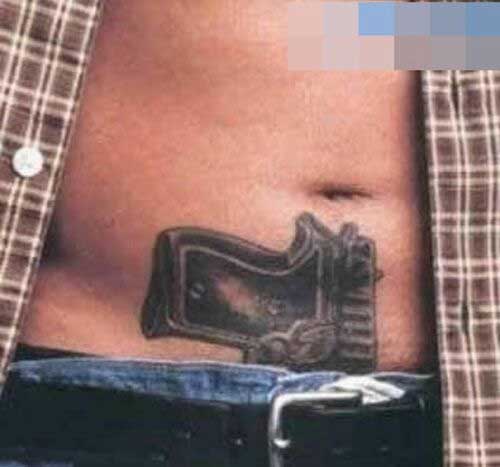
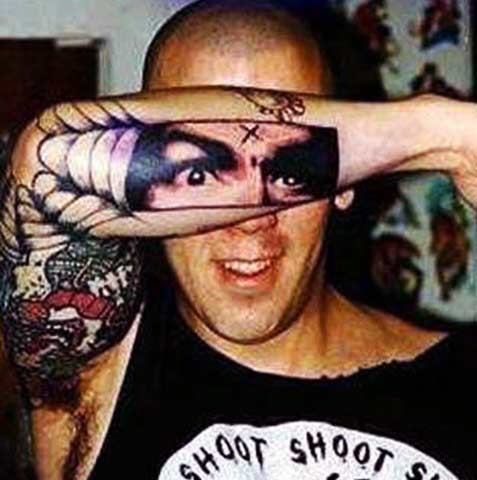
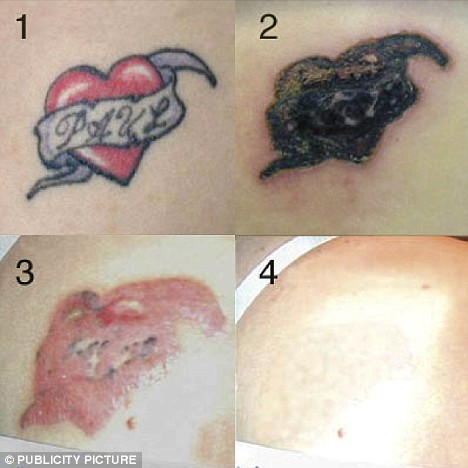


 I was recently consulted in the prison in which I work by an inmate who was the proud father of 2 children. I asked
him whether he still saw them: continued contact with their biological offspring being something of a rarity among the imprisoned paternal community. Instead of answering me directly, he rolled up his
sleeves and pointed to 2 tattoos on his forearm, red hearts with scrolls across them bearing the names of his children - 2 tattoos among many others, needless to say. He hadn’t seen either of his
children for years, and had never contributed anything to their upkeep. Indeed, the idea that he should have done so was so completely alien to him and to the mores of the world in which he moved that
the thought had never crossed his mind, even fleetingly. By contrast, he obviously believed that his tattoos were a sign of genuine devotion to his children. Their names were engraved, if not on
his heart exactly, at least on hearts painfully engraved on his skin, and one could easily imagine a touching deathbed scene in which he would be reunited at last with his children and would there show them
the tattoos as proof that he had never really forgotten or abandoned them. They would probably accept this as having been true, and therefore forgive him his dereliction of duty.
I was recently consulted in the prison in which I work by an inmate who was the proud father of 2 children. I asked
him whether he still saw them: continued contact with their biological offspring being something of a rarity among the imprisoned paternal community. Instead of answering me directly, he rolled up his
sleeves and pointed to 2 tattoos on his forearm, red hearts with scrolls across them bearing the names of his children - 2 tattoos among many others, needless to say. He hadn’t seen either of his
children for years, and had never contributed anything to their upkeep. Indeed, the idea that he should have done so was so completely alien to him and to the mores of the world in which he moved that
the thought had never crossed his mind, even fleetingly. By contrast, he obviously believed that his tattoos were a sign of genuine devotion to his children. Their names were engraved, if not on
his heart exactly, at least on hearts painfully engraved on his skin, and one could easily imagine a touching deathbed scene in which he would be reunited at last with his children and would there show them
the tattoos as proof that he had never really forgotten or abandoned them. They would probably accept this as having been true, and therefore forgive him his dereliction of duty.